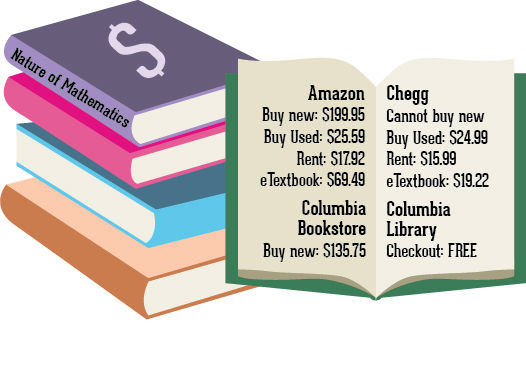Textbooks don’t have to break the bank
January 29, 2018

Textbooks don’t have to break the bank
Every semester, students purchase textbooks that can add hundreds of dollars to the cost of each term. Fortunately, there are effective ways to buy textbooks without going broke.
According to a February 2016 study by the Public Interest Research Group, the price of textbooks has increased by 73 percent since 2006.
The College Board, a nonprofit that is dedicated to expanding access to college, recommended students budget $1,200 for textbooks per year, according to a Feb. 10, 2016, NBC article.
To help students save money, Kristie Bowen, access services assistant at the Library, 624 S. Michigan Ave., said the Library provides copies of all textbooks that are priced more than $40 at the reserve desk. Science and math books are in the highest demand because they are priced at $200 or more, according to Bowen.
“Seventy percent of what we deal with on a daily basis is people coming in and using textbooks,” Bowen said.
Georgia Dimas, a junior business and entrepreneurship major, recommended that students wait until the first day of class before purchasing a textbook because, while the syllabus might say a book is required, the professor may decide the book is not necessary.
“Out of the three years I have been at Columbia, I can count the amount of times I have used a book in class. I would say no more than 10 times,” Dimas said.
To avoid the line at the bookstore, Robyn Minor, a senior cinema and television arts major, emails her professors prior to the first day of class to ask if the books will be used throughout the semester. After receiving an answer, Minor said she goes onto websites such as Valore Books to rent or purchase her textbooks.
“Every time someone asks me where I get my books, I [tell them] I get my books from [Valore Books],” Minor said. “I have seen books that are $80 or $90 normally that are $30 on Valore Books.”
Other alternatives to save money on books include Amazon and Chegg.
Dimas said another useful tool is Columbia Facebook groups. Students often post books they are selling at a low cost because the bookstore did not buy them back.
The bookstore receives book orders from professors before buybacks begin so it can determine the number of books it needs for students, according to Ann Marie Pausha, bookstore manager.
“Professors should really emphasize if we are going to use [books] because students buy these books and spend all of this money on a book they don’t even use,” Dimas said. “At the end of the semester, you are left with a book that is collecting dust on a shelf.”
Though there may be professors who identify whether or not a book is needed, professors such as Ann Hetzel Gunkel—associate professor in the Humanities, History and Social Sciences Department and Cultural Studies and Humanities coordinator—take into account selecting books for students that are affordable, accessible and include necessary content while making the textbooks list.
“Once I make selections, I make sure there is a copy of every material on reserve in the library, so if students can’t afford them, they have another way at them,” Gunkel said. “I make sure all articles are reproduced in Moodle or Canvas, so there are multiple points of access that don’t depend on a student’s financial situation.”







